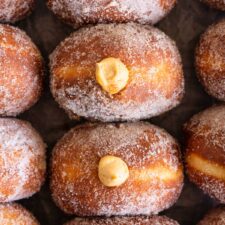Pumpkin Cheesecake Brioche Doughnuts
Your folders
Your folders
Prep Time: 45 minutes
Cook Time: 30 minutes
Total: 1 hours, 45 minutes
Servings: 12
Author : Erin Clarkson and Mike Johnson

Ingredients
Export 12 ingredients for grocery delivery
Instructions
Step 1
In a small bowl, combine the yeast, milk and 2 Tbsp of the sugar. Mix well, and leave to sit for 10-15 minutes, or until foamy.
Step 2
In the bowl of a stand mixer fitted with the dough hook, combine the flour, salt, and remaining 2 Tbsp sugar. Mix briefly to combine. Add the eggs, vanilla, and foamy yeast mixture to the bowl. Mix on low for 2-3 minutes, until the dough is starting to come together. It may look slightly dry but do not worry - it will mix together nicely in the next steps. Increase the mixer speed to medium, and mix for another 5 minutes, until the dough is soft and smooth.
Step 3
Reduce the mixer speed to low, and add the butter a little at a time, waiting until it is fully incorporated into the dough before adding the next piece. This process should take 3-4 minutes. Once the butter is fully incorporated, increase the mixer speed to medium, and mix for a further 5 minutes, until the dough is very soft and smooth.
Step 4
Transfer to an oiled bowl, and cover tightly with plastic wrap. Place in the fridge for a minimum of 3 hours and up to overnight. Alternatively the first rise can be done at room temperature.
Step 5
Line two baking sheets with parchment paper. Turn the dough out onto work surface (try not to use flour if you can). Divide into 75g portions. Roll each portion into a tight ball, making sure that they are well sealed on the bottom
Step 6
Place the rolled doughnuts on the baking sheets, flattening each one slightly, leaving adequate space between.
Step 7
Leave the doughnuts to proof for a second time. This rise time will depend on the weather and the temperature of your starting dough so will take anywhere between 20 minutes to an hour. When you poke them lightly with your finger, it should leave a small indentation that springs back.
Step 8
While the doughnuts are proofing, heat neutral oil in a large heavy-bottomed pot (cast iron works great). Heat the oil to 350°f / 180°c. Place a wire rack over a baking sheet lined with parchment paper.
Step 9
Once the oil has come to temperature, test it with a few scraps of dough. Gently lower the doughnuts, two at a time, into the hot oil. Cook for 3 minutes on one side and then flip again, and cook for a further 3 minutes, until golden brown. Remove from the oil using a slotted spoon and place on a cooling rack.
Step 10
Allow to cool for 30 seconds before tossing in the sugar. Repeat the process with the rest of the doughnuts. Once the doughnuts are totally cool, poke a hole in them using a chopstick, and widen the hole using your finger.
Step 11
Combine all ingredients in a bowl. Have ready for when frying the doughnuts.
Step 12
Place the pumpkin into a medium saucepan. Cook over medium heat, stirring constantly, for 4-5 minutes until reduced slightly. Set aside to cool, and then measure out 200g of reduced pumpkin.
Step 13
Place the reduced pumpkin along with all other ingredients in a medium bowl. Stir to incorporate with a rubber spatula, then switch to a whisk and whip until well incorporated. (If you like you can bang everything into a stand mixer fitted with the whisk attachment and mix until combined).
Step 14
Transfer the pumpkin cheesecake filling into a piping bag fitted with a round attachment. Fill each doughnut with pumpkin cheesecake filling, finishing with a little blob on the top.